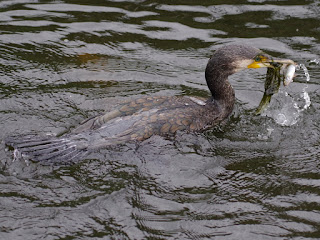Two Cormorants were fishing efficiently under the balustrade of the Italian Garden, hauling up one perch after another.
The young Grey Heron at the Dell restaurant had won a slice of pizza.
It found this large flat thing impossible to swallow, and flew off to its usual place on the raft to deal with it.
A young Herring Gull was playing with a plastic and metal object which I think was the broken hinge of a folding pushchair.
The pair of Nuthatches in the leaf yard came down to take pine nuts from the railings.
In the Rose Garden, a Feral Pigeon was bathing in the original Diana fountain -- nothing to do with the princess, it has a statue of the goddess Diana on it.
After the pigeon had finished bathing, it perched on her bow, spoiling her aim.
She is aiming at the statue of Lord Byron 200 yards away in Park Lane. Note sure whether this is deliberate, but it is a fitting action by a virgin goddess towards a louche old poet.
The female Little Owl was on her nest tree near the leaf yard, but shortly afterwards she was attacked by a Magpie and fled into her hole. There are now a great many Magpies in the area, and they are bothering her a lot.
On the leaf yard railings, a Rose-Ringed Parakeet and a Magpie were having a face-off over an apple. The parakeet was winning ...
... until a second Magpie came up from behind and knocked it off. The first Magpie had to wait until it had finished eating before it could have a go at the apple.
Another Magpie was eating berries on one of the rowan trees on Buck Hill.
The rowan's scientific name is Sorbus aucuparia. Two other members of the Sorbus genus were also providing berries, a whitebeam, S, aria, here visited by a Wood Pigeon ...
... and a wild service tree, S. torminalis, with another Wood Pigeon.
The English name of this tree comes from all parts of it being useful. The berries are edible by humans when overripe and brown, and taste like dates. They were formerly used as a remedy for colic, and also to flavour beer before the introduction of hops.












That's a saucy perch for a pigeon! A peregrine on her shoulder might be more appropriate.
ReplyDeleteThat made me wonder whether the ancients practised falconry. It seems not -- it was introduced from the east by the barbarian hordes who were destroying the Roman empire at the time.
Delete